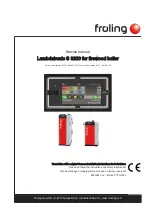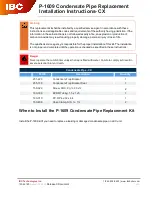
INSTALLATION, OPERATION & MAINTENANCE
3-2
Pipe lengths and fittings must be calculated as part of the equivalent length. The pressure drop of the
vent and combustion air systems must not exceed 100 equivalent feet each. Note that this
DOES
NOT
mean the allowed combined pressure drop between the vent and combustion air is 200 equivalent feet.
That is, the vent cannot go above 100 equivalent feet, even if the combustion air is less than 100
equivalent feet, and vice versa. (See GF-115-V for detailed sizing guidelines.)
The combustion air must be free of chlorine, halogenated hydrocarbons, or other chemicals that can
become hazardous when used in gas-fired equipment. Common sources of these compounds are
swimming pools, degreasing compounds, plastic processing compounds and refrigerants. Whenever
the environment contains these types of chemicals, combustion air must be supplied from a clean area
outdoors for the protection and longevity of the equipment.
The Modulex is CSA listed for 100% sealed combustion or can be installed using room air as long as
there is an adequate supply. (See GF-115-V for detailed sizing guidelines.)
3.4 REMOVAL OF EXISTING BOILER FROM COMMON VENTING SYSTEM
At the time of removal of an existing boiler, the following steps shall be followed with each appliance
remaining connected to the common venting system placed in operation, while the other appliances
remaining connected to the common venting system are not in operation.
1. Seal any unused openings in the common venting system.
2. Visually inspect the venting system for proper size and horizontal pitch and determine there are
no blockages or restrictions, leakage, corrosion and other deficiencies that could cause an
unsafe condition.
3. When practical, close all building doors and windows as well as all doors between the space in
which the appliances remaining connected to the common venting system are located and
other spaces of the building. Turn on any appliances not connected to the common venting
system, such as clothes dryers. Turn on any exhaust fans, such as range hoods and bathroom
exhausts, so they will operate at maximum speed. Do not operate a summer exhaust fan.
Close fireplace dampers.
4. Turn on the appliance being inspected. Follow the lighting instructions. Adjust thermostat so
appliance will operate continuously.
5. Test for spillage at the draft hood relief opening after 5 minutes of main burner operation. Use
the flame of a match or candle, or smoke from a cigarette, cigar or pipe.
6. After it has been determined that each appliance remaining connected to the common venting
system properly vents when tested as outlined above, return doors, windows, exhaust fans,
fireplace dampers and any other gas-burning appliance to their previous state of use.
7. Any improper operation of the common venting system should be corrected so the installation
conforms to the National Fuel Gas code, ANSI Z223.1 and/or CAN/CGA B149, Installation
Codes. When resizing any portion of the common venting system, the common venting system
should be resized to approach the minimum size as determined using the appropriate tables in
Part 11 of the National Fuel Gas Code, ANSI Z223.1 and/or CAN/CGA B149, Installation
Codes.
Summary of Contents for Modulex 1060
Page 16: ......
Page 25: ...INSTALLATION OPERATION MAINTENANCE 2 9 Figure 2 7 Sample Data Plate ...
Page 33: ...INSTALLATION OPERATION MAINTENANCE 5 3 Figure 5 2 ...
Page 34: ......
Page 44: ......
Page 51: ...APPENDIX A A 1 APPENDIX A Temperature Sensor Resistance Charts ...
Page 53: ...APPENDIX B B 1 APPENDIX B Modulex Parts List ...
Page 54: ...APPENDIX B B 2 ...
Page 55: ...APPENDIX B B 3 ...
Page 56: ...APPENDIX B B 4 ...
Page 58: ......
















































